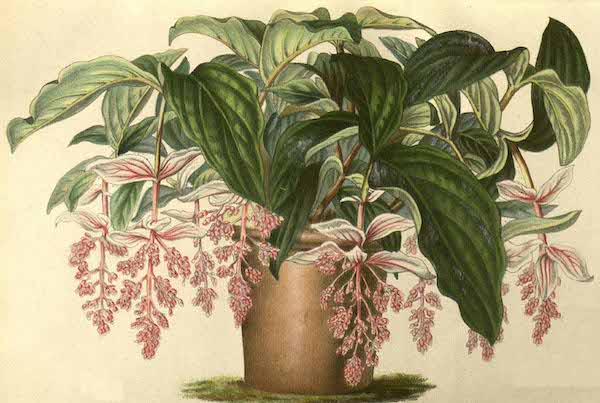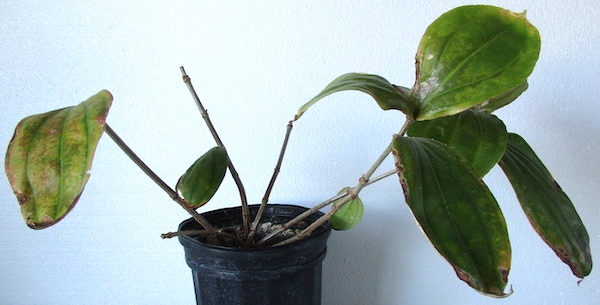| At least 9 Medinilla species have been sold for houseplant usage, but really need a greenhouse or large terrarium to get enough humidity to thrive. When thriving, they are beautiful, and large. Here is a bit of information about the genus and my limited experience. |
| Medinilla consists of 380 spp. of tropical Africa, Madagascar, New Guinea, the S Pacific, Australia, and New Caledonia. The species are small trees, shrubs and weak vines --mostly epiphytic. Stems can be 4-angled. Leaves are opposite or whorled; 3–5 veined; hairless usually. Flowers vary but are usually small, though can be in large clusters, drooping gracefully. Fruit a berry, sometimes edible. |
| My two clones of Medinilla Cumingii grew slowly, attracted spider-mites, and never bloomed, but their leaves tasted delicious raw; sour. I grew one Medinilla Cummingii starting in 2016; the other since 2021. Some Medinilla leaves are astringent. |
Three more common kinds cultivated are:
|
M. Cumingii Naud. (Showy Asian Grapes)
|
M. magnifica Lindl. (Pink or Magnificent Medinilla. Love Plant. Rose Grape. Kapa-Kapa Plant)
|
M. multiflora Merr. [= M. myriantha Merr.] (Malaysian Orchid or Grapes)
|
| The leaves of at least 6 Medinilla species are reported edible, and the berries of over a dozen spp. Presumably, others are safe to sample. The issue is, if all the Medinilla are slow growing indoors, pest-prone, and need careful attention to temperature and humidity . . . then growing them to eat is not worthwhile in a reasonable cost / benefit analysis. Other houseplants are less trouble and more rewarding. |
In a beauty contest, however, Medinilla can win, if well grown and seen in bloom or laden with ripe fruit. The lovely drawing reproduced below is from Van Houtte's Flore des Serres et des Jardin de l'Europe 1914. It shows leaves and flowers, not fruit.
Back |

Medinilla magnifica ; 1914
|

Medinilla Scortechinii in a greenhouse; photo by ALJ
|

Medinilla Cumingii miserable as houseplant; photo by ALJ
|

